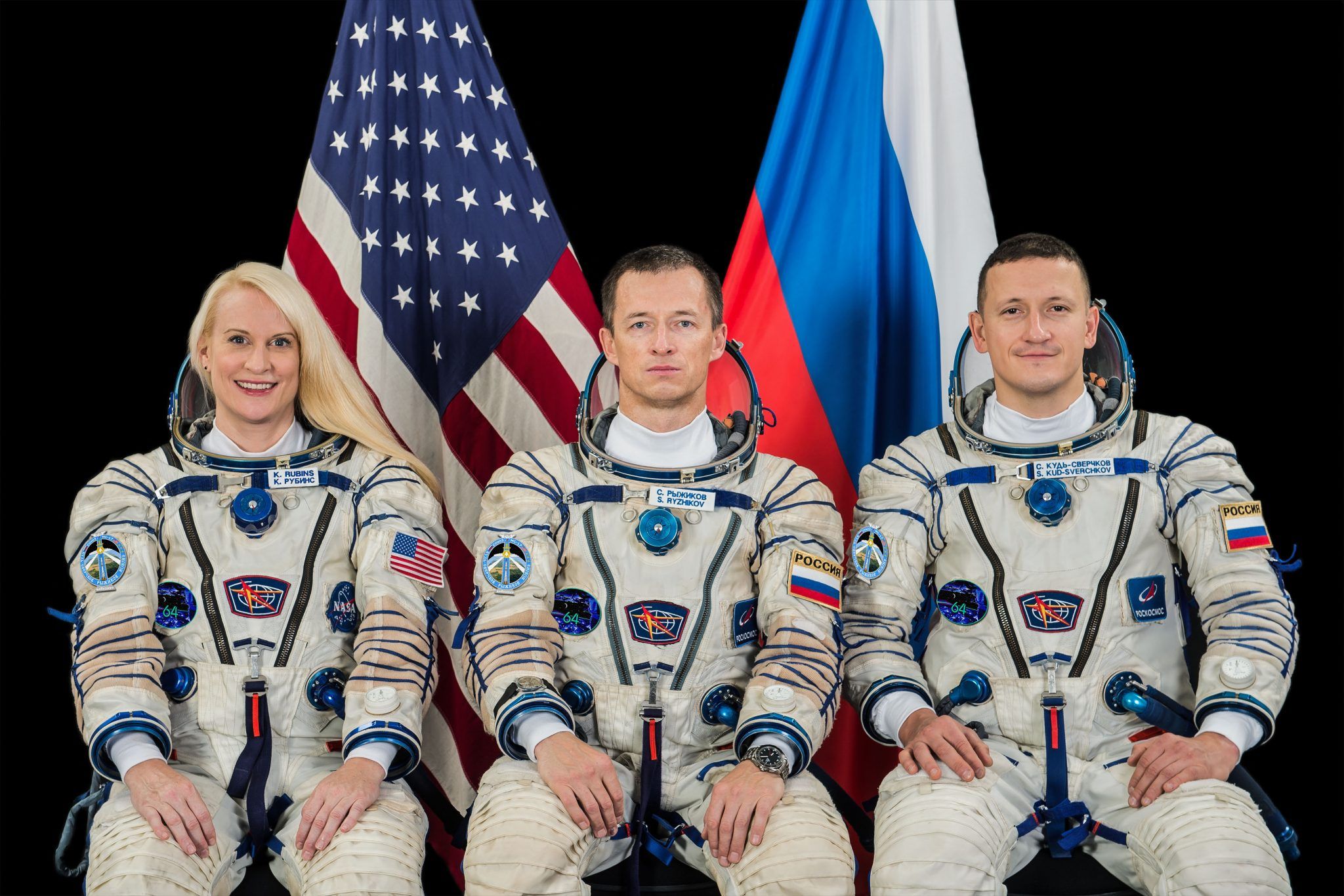Russian Cosmonauts On How to Greet Extraterrestrials
September 24, 2020 (sputniknews.com)
• On September 24th, Russian cosmonaut Sergei Kud-Sverchkov spoke at a press conference organized by the government news agency, Rossiya Segodnya. Flight engineer Kud-Sverchkov will join mission commander Sergei Ryzhikov and NASA astronaut Kathleen Rubins in the ‘Expedition 64’ (all pictured above) to the International Space Station in October. This will be Kud-Sverchkov’s first flight to space.
• Russian scientists join with those from other countries in the search for extraterrestrial life, making plans to launch multiple new scientific missions to the Moon, Mars and Venus, and, earlier this year, announcing the construction of a high-powered telescope that can be used to search for signals from extraterrestrial civilizations transmitted in the optical spectrum.
• In 2012, veteran cosmonaut Gennady Padalka told Chinese media that “detailed instructions” had been created at the United Nations “in case of first contact” with extraterrestrial beings. He added at the time that “sooner or later we will meet our like-minded brothers” from another planet.
• However, Kud-Sverchkov sats that Russian cosmonauts have not been given any special instructions when it comes to greeting aliens, but would try to do so in a diplomatic matter. “I think that when meeting intelligence extraterrestrial life, we will exhibit friendliness, goodwill and consideration, just as we do when meeting intelligent and unintelligent life on Earth,” the cosmonaut said.
• The Soyuz MS-17 spacecraft will blast off from the Baikonur Cosmodrome in Kazakhstan on October 14th upon a Soyuz-2.1 ‘carrier rocket’. The spacecraft expected to reach the ISS in a record 3 hours, 20 minutes. The mission will last until April 2021, during which the team will activate the Bartolomeo scientific platform outside the European Space Agency’s Columbus lab module. Ryzhikov, Kud-Sverchkov and Rubins will be joined by three more NASA astronauts and a Japanese astronaut, who will make their way to the ISS in a SpaceX Crew Dragon capsule shortly after the Soyuz craft’s arrival.
• A cosmonaut doll knitted by Kud-Sverchkov’s wife will become the expedition’s mascot, named Yuri after Yuri Gagarin, the first human being in space. Mission commander Ryzhikov told reporters that he would take with him a miniaturized set of Gospels, as well as a handful of Russian soil and stones from Mount Tabor, which Christians believe was the site of the transfiguration of Jesus following his resurrection.
• NASA astronaut Kathleen Rubins said she plans to collect thousands of microbial samples inside the space station, and revealed that she plans to vote in the US presidential election from aboard the ISS.

As one of the world’s major space powers, Russia has done its part helping humanity search for extraterrestrial life,

recently beginning the construction of a powerful telescope capable of searching for signals coming from distant alien civilisations.
Russian cosmonauts have not been given any special instructions when it comes to greeting aliens, but would try to do so in a diplomatic matter, cosmonaut Sergei Kud-Sverchkov has said.
“I think that when meeting intelligence extraterrestrial life, we will exhibit friendliness, goodwill and consideration, just as we do when meeting intelligent and unintelligent life on Earth,” the cosmonaut said, speaking at a press conference organized by Rossiya Segodnya, on Thursday.
Kud-Sverchkov will join mission commander Sergei Ryzhikov in Expedition 64 to the International Space Station in

October as a flight engineer. This will be his first flight to space.
The Soyuz MS-17 spacecraft will carry the two Russian cosmonauts and NASA astronaut Kathleen Rubins to the ISS aboard a Soyuz-2.1a carrier rocket blasting off from the Baikonur Cosmodrome in Kazakhstan on October 14,

with the spacecraft expected to reach its destination in a record 3 hours, 20 minutes.
Kud-Sverchkov says a knitted cosmonaut doll named Yuri will become the mascot for Expedition 64, with the doll knitted by his wife, and named after Yuri Gagarin, the first human being in space.
Mission commander Ryzhikov told reporters that he would take with him a miniaturized Gospels, as well as a handful of Russian soil and stones from Mount Tabor, which Christians believe was the site of the transfiguration of Jesus following his resurrection.
For her part, NASA astronaut Kathleen Rubins said her plans include work collecting thousands of microbial samples inside the space station, and revealed that she plans to vote in the US presidential election from aboard the ISS.
FAIR USE NOTICE: This page contains copyrighted material the use of which has not been specifically authorized by the copyright owner. ExoNews.org distributes this material for the purpose of news reporting, educational research, comment and criticism, constituting Fair Use under 17 U.S.C § 107. Please contact the Editor at ExoNews with any copyright issue.


